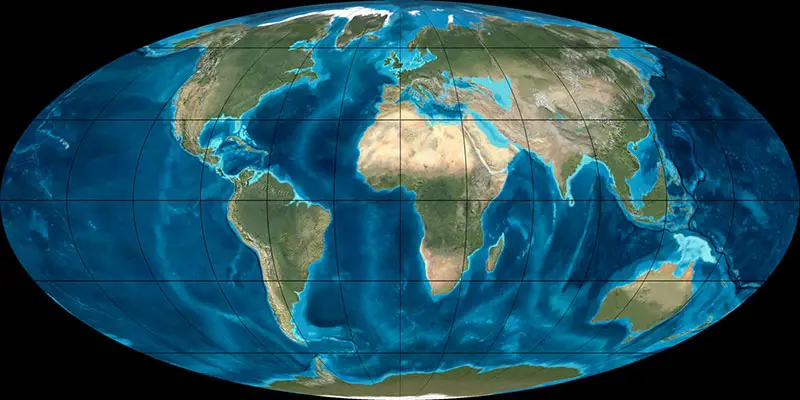†Victoriapithecus (Victoriapithecidae)
Victoriapithecus ist eine Primatengattung innerhalb der Familie Victoriapithecidae, deren 2 Mitglieder ab dem frühen Neogen (Miozän) im Aquitanium lebten, das vor ungefähr 23 Millionen Jahren begann und bis vor 20,4 Millionen Jahren andauerte. Viele Überreste wurden in Kenia gefunden.
Victoriapithecus aus der Familie Victoriapithecidae innerhalb der Überfamilie Cercopithecoidea war im Miozän in Afrika verbreitet.
Die Überreste von Victoriapithecus mcinnesi stammen aus etwa 14 Millionen Jahre alten Sedimenten auf den Insel Maboko.
Victoriapithecus macinnesi
Im Miozän gab es in Afrika eine atemberaubende Vielfalt von Hominoiden, aber nur erstaunlich wenige Affen und sie lebten nur selten zusammen mit Menschenaffen. Eine der interessantesten Ausnahmen ist der Affe Victoriapithecus macinnesi, der auf Maboko Island offenbar Seite an Seite mit dem primitiven Menschenaffen Equatorius lebte.
| Sammlung | Kommentar zum Fundort | Epoche, Alter | Geologie, Formation | Kommentar zur Sammlung |
|---|---|---|---|---|
| Majiwa | Maboko | ETE Locality 138, Majiwa, Majiwa Bluff, | ||
| Kommentar z. Stratigraphie | Lithographie | |||
| ETE dating method: composite, ETE age comment: equivalent in age to Maboko sites (14-16 Ma); overlying Kisumu Phonolite dated by K/Ar at 12.3 +/- 0.02 My radiometric intage_min | ETE rock type adj: ., ETE lithology comments: silty conglomerates |
| Physiologie | |
|---|---|
| Gewicht: | ? |
| Schwestertaxa | |
Analysen der postcranialen Knochen zeigen, dass Victoriapithecus ein kleiner Affe mit etwa 3 bis 5 Kilogramm Körpergewicht war. Er besaß einige Anpassungen wie verkürzte Finger und Zehen und Schwielen am Gesäß, was ihn mit einer terrestrischen Lebensweise in Verbindung bringt. Möglicherweise ähnelte Victoriapithecus mcinnesi in dieser Hinsicht heutigen grünen Meerkatzen (Chlorocebus). Im Jahr 1997 fanden McCrossin & Benefit (1997) einen kompletten Schädel von Victoriapithecus, der bis heute der älteste Schädel eines afrikanischen Affen aus dem Miozän ist. Sein EQ (Enzephalisationsquotient) ist auch typisch für heute lebende kleine Affen.
Literatur
P. Andrews, G. E. Meyer, D. R. Pilbeam, J. A. Van Couvering, J. A. H. Van Couvering 1981, The Miocene fossil beds of Maboko Island, Kenya: Geology, age, taphonomy, and palaeontology. Journal of Human Evolution. 10, p. 35 - 48, DOI: 10.1016/S0047-2484(81)80024-3M. Pickford, G. E. Meyer, D. R. Pilbeam, J. A. Van Couvering, J. A. H. Van Couvering 1982, New Higher Primate Fossils from the Middle Miocene Deposits at Majiwa and Kaloma, Western Kenya. American Journal of Physical Anthropology. 58, p. 1 - 19, DOI: 10.1016/S0047-2484(81)80024-3
B. R. Benefit, M. L. McCrossin, D. R. Pilbeam, J. A. Van Couvering, J. A. H. Van Couvering 1989, New primate fossils from the Middle Miocene of Maboko Island, Kenya. Journal of Human Evolution. 18, p. 493 - 497, DOI: 10.1016/S0047-2484(81)80024-3
T. Harrison, M. L. McCrossin, D. R. Pilbeam, J. A. Van Couvering, J. A. H. Van Couvering 1989, A new species of Micropithecus from the middle Miocene of Kenya. Journal of Human Evolution. 18:6, p. 537 - 557, DOI: 10.1016/S0047-2484(81)80024-3
C. S. Feibel, F. H. Brown, D. R. Pilbeam, J. A. Van Couvering, J. A. H. Van Couvering 1991, Age of the primate-bearing deposits on Maboko Island, Kenya. Journal of Human Evolution. 21:6, p. 221 - 225, DOI: 10.1016/S0047-2484(81)80024-3
M. Pickford, F. H. Brown, D. R. Pilbeam, J. A. Van Couvering, J. A. H. Van Couvering 1992, Evidence for an arid climate in western Uganda during the middle Miocene. Comptes Rendus Acad. des Sci.,serie II. 315:11, p. 1419 - 1424, DOI: 10.1016/S0047-2484(81)80024-3
M. L. McCrossin, F. H. Brown, D. R. Pilbeam, J. A. Van Couvering, J. A. H. Van Couvering 1992, New species of bushbaby from the Middle Miocene of Maboko Island, Kenya. American Journal of Physical Anthropology. 89:11, p. 215 - 233, DOI: 10.1016/S0047-2484(81)80024-3
A. J. Winkler, F. H. Brown, D. R. Pilbeam, J. A. Van Couvering, J. A. H. Van Couvering 1997, Systematics, Paleobiogeography, and Paleoenvironmental Significance of Rodents from the Ibole Member, Manonga Valley, Tanzania. Neogene Paleontology of the Manonga Valley, Tanzania. Plenum Press, New York and London. :11, p. 311 - 332, DOI: 10.1016/S0047-2484(81)80024-3
M. Pickford, B. Senut, D. Gommery, E. Musiime 2003, New Catarrhine fossils from Moroto II, Early Middle Miocene (ca 17.5 Ma) Uganda. Comptes Rendus Palevol. 2:8, p. 649 - 662, DOI: 10.1016/S0047-2484(81)80024-3
